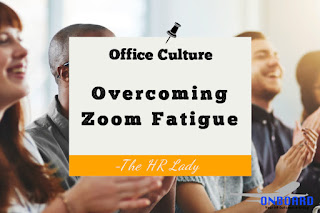Office Culture: Overcoming Zoom Fatigue
Video conferencing software is a necessary evil in the current business landscape. It helps us connect on a virtual level, but it also comes with some serious drawbacks. Cue the dreaded "Zoom Fatigue". It's real! Your employees, coworkers and colleagues are not just making excuses to avoid video contact. This new-found workplace issue has been researched, and here are a few reasons why it causes us so much stress:
Problem #1. Absence of Non-Verbal Cues
In daily, face-to-face conversation, we rely on non-verbal cues to let us know when someone is excited, or concerned, or has finished speaking. These allow us to continue the conversation flow and get our points across to colleagues. Without these non-verbal cues, our brain has to go into overdrive to analyze every word that is spoken. This is similar to text and email. Without these non-verbal, in-person cues, comments and presentations can become something they are not meant to be.
Problem #2. Performance Anxiety
This seems silly at first, because typically you are alone when you are 'zooming'. But, think about it. You are on camera, or 'stage', while you are speaking. All eyes are on you, and in some cases, your every word and move is being recorded. When you take a drink of coffee, fix your shirt or take notes, all eyes are on you- whether you are speaking or not!
Problem #3. Silence
In everyday conversation, silence is one of those non-verbal cues, that help move the conversation along. It helps the speaker get into a rhythm, and allows for comments, questions or listeners to take notes. On a video conference, silence means something completely different! If you are the speaker, it can mean that all attendees hate your ideas and your guts! For the attendees, it can mean that they have lost service or the software is malfunctioning. An example is conducting an interview. As the interviewer, you ask a question, and then write down the response. If you writing takes longer than the verbal response, there is a delay. This leads to a lot of 'Hello, are you still there?".
Now that your disgust for excessive video conferencing has been explained, let's explore some solutions and tips to give you and your employees some "Zoom Relief". (Because, let's face it, video conferencing is our current way of business life.)
Solution #1: Utilize Other Platforms
We have all seen the funny memes that say "just survived another meeting that could have been an e-mail." Yea, this is still a thing, except it applies to video conferencing. If something can happen over the phone or through e-mail, then please, we beg you, use those platforms. There is nothing worse then having to linger on a five minute video conference that clearly could have been a two-paragraph email, just to have to schedule a consecutive video conference to see a presentation on the same topic.
Solution #2: Avoid Over-Stimulation
When we are on a video call, we are not only processing each participant, but also their office space! Encourage your employees or colleagues to use PLAIN backgrounds. If you are having frequent inter-office meetings, create a simple background for all employees to use. The consistency will help reduce over stimulation. If you are on an outside business conference, ask that all attendees have a plain background of the same color or same scene with just their logo present. (Since almost everyone has their name appear on their 'window', putting a participants name on their background is not necessary.) You can also ask all participants to turn off their video when they are not speaking.
Solution #3: Allow for Introductions
If you are the host, allow for everyone to ground themselves and introduce themselves to the group. Even if this is a simple 'Hi" for a weekly meeting. Most meetings do not start the second you walk into the conference room, so try to keep that same culture when hosting a video call. Also, remind yourself that this is a new thing, and it is OK to not like it. You are in some alternate universe between present and absent. But, so is everyone else. Remember, we are all in this together!
Solution #4: Choose Speaker View
When in a meeting, it is normal to focus on the person speaking. This etiquette should carry over to video conferencing. Most platforms have a setting to select 'speaker view'. This will put the person speaking, front and center, instead of having to decipher who is talking in a screen that looks like the Brady Bunch on steroids.
Solution #5: Avoid Multi-tasking
I debated adding this because I am an avid multi-tasker. I do not enjoy sitting and relaxing, and if we are on the phone, I am most likely doing a few other things while speaking with you. But, as a culture, we need to stop this, or at least reduce it. When you are on a video call, put all of your focus on the speaker and take notes. Look at the video conference as any other meeting where you are busy or unavailable to complete other tasks.
Solution #6: Take 5
Most meetings do not last over an hour without some sort of break. Video-conferences shouldn't either. Give attendees a break between speakers to gather thoughts, get a drink or use the restroom. Allow them a few moments to rest their brain before absorbing more information. Even Indy-car drivers get pit stops.
Solution #7: Optional Social Hour
Being a social butterfly, I try to attend as many networking events as possible...but, depending on my day, I am not always up for a social Zoom. Social events are great, but be sure to let attendees know they are welcome but not required to attend. Also, have a moderator greet everyone, and give instructions. You can also use break out rooms for large groups.
The struggle is real when it comes to the desire to be face-to-face, but too many video conferences have their own issues. Be sure to balance this platform, and add in a few of our solutions above. If you have any questions or need additional resources, please reach out to us!
|



Comments
Post a Comment